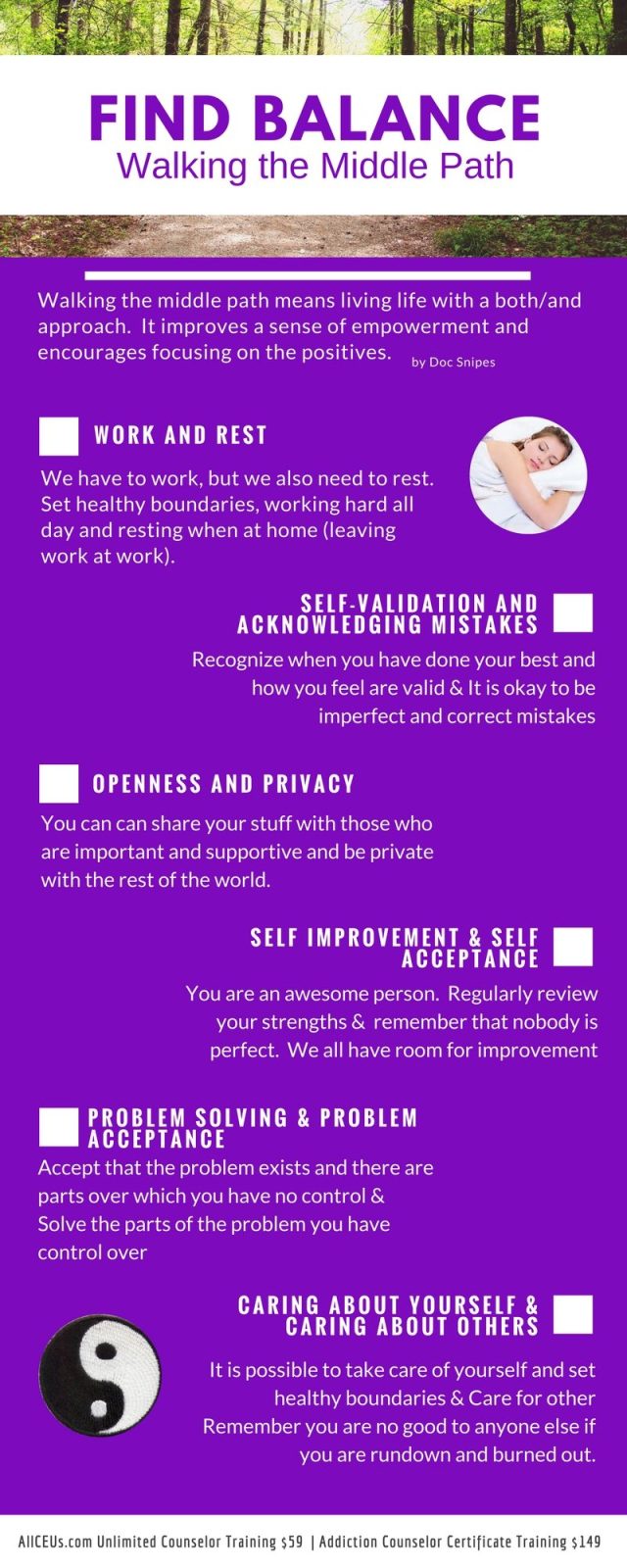
The middle path is about balance. It is an alternative to black-and-white thinking and polarization, both of which are particularly common among people with emotion regulation issues, but which everyone is prone to from time to time. These activities are particularly enlightening when you do them with someone else or in a group.
Here are some examples of opposites that can both be true. Think about or discuss how each statement can be true.
- You are independent, and you need help.
- You want to be alone, and you want connection with others.
- You can accept yourself the way you are and want to change.
- Someone else can have valid reasons for wanting something from you, and you can have valid reasons for saying no.
- You can be mad at someone and still love and respect them. (You can be mad at yourself, and still love and respect yourself.)
- You can be doing the best you can, and still need to do better and try harder.
- You can understand the motivations for someone’s behavior, and also think that it’s wrong and the person ought to change it.
- You can be around others, and be lonely.
Similarly, here are some examples of opposites one might need to balance with the middle path. For each, explain how you can balance these and why both “poles” in each statement are important to your recovery.
- Work and rest.
- Self-validation and acknowledging mistakes.
- Openness and privacy.
- Observation and participation.
- Self-improvement and self-acceptance.
- Problem-solving and problem acceptance.
- Caring about yourself and caring about others.
- Emotion regulation and emotion acceptance.
Here are three lessons that you can learn from dialectics:
There’s more than one side to each situation. There’s more than one way to look at a situation or solve a problem. Two things that seem like opposites can both be true. People who disagree with you can still have correct opinions. Remember that people's behavior and thoughts make sense from their own point of view.
Ask yourself: what am I missing? What truth does the opposing view hold? Let go of extremes: think “sometimes” instead of “always” and “never”, think “both/and” instead of “either/or”. Be willing to play devil’s advocate. Be curious, not furious.
When something happens that triggers anxiety, anger or depression, look for 3 other explanations for why it could have happened and three other hypotheses for what could happen and three options for what you could do. Example: Someone has different political views than you do. What are three reasons they might have this perception? Your initial reaction was that their view presented a threat to you. What are three other possible outcomes if they are allowed to hold their views? What are 3 options for ways you could handle it? (Facilitator hints: Present evidence to support your views and be open to research that supports their views, let it go, argue with them about it)
The only thing that doesn’t change is change. Nothing is constant. Every time it seems like you’ve gotten things settled, they change again. Your moods, relationships, even the cells of your body are constantly changing.
Throw yourself into change. Don’t just allow it; embrace it. Accept the unpredictable. Accepting change can be particularly hard if you feel insecure and need others for validation. It feels like changes mean that you’re going to be abandoned. If you have a hard time coping with change, remember how many times things have changed and you have not only survived but succeeded.
Develop a how to handle change plan. Have clients identify what a rich and meaningful life looks like to them, (their goals). Now have them identify how they can identify change as a challenge and adjust to it in a way that continues to help them meet their goals. Give them the example of getting a promotion or a new job. How can they adjust to that and still keep working toward all of their other goals (Hint: Balance family, friends, self care with work).
Change is transactional. What we do influences our environment and other people; what the environment and other people do influences us. Pay attention both to your effect on others and their effect on you. Let go of blame by thinking about how both your actions and other people’s are caused a life of learning–for better or worse. People do things for reasons. Be aware of the fundamental attribution error. That is, we assume that when we kick the vending machine, it’s because we had a bad day (external attribution), but if someone else kicks the vending machine, it’s because they’re an angry person.(internal attribution) (Beware of it, as well, with regards to yourself. Many people, particularly those with a tendency towards depression, assume that every mistake they make means they are fundamentally awkward, ugly, stupid, evil, or just plain bad.)
Ask clients to think about their day. In what ways did they influence their environment and other people? In what ways did other people influence them? How did their environment influence them? (Facilitator's prompt: Would you act the same way at home and at work?)
Examine a transaction: Jane comes to work in a bad mood and is rude to Sally. This makes Sally angry. At lunch Jane is in a better mood, but Sally is still hurt and ignores Jane. This hurts Jane's feelings….
Now have clients identify a situation that led them to an emotionally charged moment and identify the transactions that led up to that moment. OR Identify an example such as… “Samantha feels like nobody loves her and life his hopeless.” Hypothesize what could have led up to Samantha feeling this way.
Counseling CEUs are available
